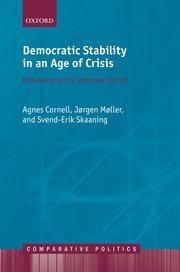 Democracies are better equipped to cope with crises like the current Covid-19 pandemic and at less risk of institutional breakdown than many commentators believe, new research suggests. Comparisons of the current threats to democracy with the authoritarian upsurge of the inter-war years are based on superficial analysis and a misreading of historical events, Agnes Cornell, Jørgen Møller, and Svend-Erik Skaaning conclude in Democratic Stability in an Age of Crisis: Reassessing the Interwar Period, Oxford University Press (2020). Indeed, democratic quality increased even in the crisis-prone 1930s in states with a robust democratic legacy and a strong associational landscape.
Democracies are better equipped to cope with crises like the current Covid-19 pandemic and at less risk of institutional breakdown than many commentators believe, new research suggests. Comparisons of the current threats to democracy with the authoritarian upsurge of the inter-war years are based on superficial analysis and a misreading of historical events, Agnes Cornell, Jørgen Møller, and Svend-Erik Skaaning conclude in Democratic Stability in an Age of Crisis: Reassessing the Interwar Period, Oxford University Press (2020). Indeed, democratic quality increased even in the crisis-prone 1930s in states with a robust democratic legacy and a strong associational landscape.
That the interwar period contained two kinds of democracies – the resilient and the fragile – might sound like a truism that simply kicks the ball further down the field but does little to explain variations in interwar democratic stability. However, it is possible to identify the baseline risk of breakdown on the eve of the interwar period. This baseline risk—determined by deep structural factors that decided whether European and Latin American countries entered the interwar period bolstered by democratic legacies—largely explains why some democracies survived whereas others broke down, even though it does not explain the specific timing of the numerous breakdowns.
We have identified the more proximate factors through which auspicious structural conditions stabilized democracies in the 1920s and 1930s. Most importantly, our empirical analyses show that the strength of the associational landscape affected democratic stability in the interwar period in a consistent and non-trivial manner. While the dense associational landscapes in Germany, Austria, and Italy might well have fuelled the flames of anti-democratic and, ultimately, totalitarian mobilization, as a revisionist literature claims, this was not a general pattern. It seems to be a country-specific phenomenon, which is probably related to defeat (Austria and Germany) or squandered victory (Italy) in World War I, but which was reinforced
by the absence of a legacy of pre-war democratic competition for power in these countries and by the continued existence of a strong class of noble landowners, who helped undermine the loyalty of conservative parties to the new regime form.
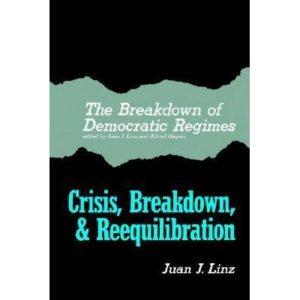 In no other interwar instances does it seem as though strong civil societies are related to democratic breakdown. To be sure, there was significant anti-democratic mobilization in countries such as Belgium, Finland, and France, all of which had strong parties and vibrant civil societies. However, democracy survived in these three ‘near misses’ as coalition of moderate parties, with strong links to civil society organizations, effectively checked radicalized groups and parties in the 1930s.
In no other interwar instances does it seem as though strong civil societies are related to democratic breakdown. To be sure, there was significant anti-democratic mobilization in countries such as Belgium, Finland, and France, all of which had strong parties and vibrant civil societies. However, democracy survived in these three ‘near misses’ as coalition of moderate parties, with strong links to civil society organizations, effectively checked radicalized groups and parties in the 1930s.
Moreover, the general picture was different. In the cases with vibrant associational landscapes, concentrated in what we have termed north-western Europe and the former British settler colonies, democracy survived despite a series of potentially destabilizing crises. In fact, we have found little evidence of anti-democratic mobilization in most of these countries, whether in the streets or in parliament. Instead, the established parties were able to hold on to their voters, to assure farmers and workers that the parliamentary channel was the best way to address their plight, and to close the political spectrum to extremist forces to their right
and left.
In Latin America, the Southern Cone countries (Argentina, Uruguay, and Chile) and Central American Costa Rica scored highest on the associational landscape variables and were the countries that had pre-war democratic legacies. While democracy was not nearly as robust in these countries as in the north-western Europe, it was clearly more robust than in the rest of Latin America. These findings are part of a more general pattern. In the cases scoring low on our associational landscape variable, the interwar period was characterized by almost endemic political crisis. The political systems in these countries were unable to channel the frustration created by the repeated interwar crisis episodes.
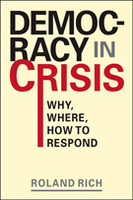 In some places, this frustration was vented in the streets by anti-democratic movements, which in many cases also received substantial popular backing at elections. In other places, reactionary elites where able to introduce autocratic rule without much resistance from below.
In some places, this frustration was vented in the streets by anti-democratic movements, which in many cases also received substantial popular backing at elections. In other places, reactionary elites where able to introduce autocratic rule without much resistance from below.
These were new and socio-economically low-developed democracies with weak associational landscapes that were, broadly speaking, a result of the victory of the democratic great powers in World War I and US democracy promotion in Latin America. They differed in many ways but what they had in common were fragile democratic systems. This commonality is illustrated by the timing of the democratic breakdowns in this group of countries.
Re-democratizations
Some of these breakdowns (e.g., Romania and Bulgaria) occurred very early in the day, in the immediate aftermath of the initial democratizations. Others were scattered throughout the 1920s, including the breakdowns in Lithuania and Poland in 1926, the 1927 breakdown in the Dominican Republic, and the breakdown in Yugoslavia in 1929. More followed in the 1930s. In Europe, this negative trend really took off with the January 1933 breakdown in Germany; thereafter democracies broke down in Bulgaria, Estonia, Latvia, and Spain, and no re-democratization occurred anywhere in Europe in the remainder of the decade. In Latin America, almost all of the breakdowns took place in the 1930s, but we also find two re-democratizations in this decade in countries with pre-war democratic legacies and moderately strong associational landscapes, Chile in 1934 (where democracy had been terminated by a military coup in 1924) and Uruguay in 1938 (where democracy had been terminated by a self-coup in 1933).
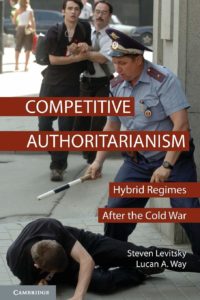 Most of the new democracies of the interwar period were so fragile that they could break down for very different reasons, some of which were idiosyncratic. This is reflected in a number of very short democratic spells that have been ignored by much of the prior literature. We find these brief and interrupted spells—sometimes lasting less than a year, often less than one electoral cycle—both in Europe, where Bulgaria and Romania are the most obvious examples,
Most of the new democracies of the interwar period were so fragile that they could break down for very different reasons, some of which were idiosyncratic. This is reflected in a number of very short democratic spells that have been ignored by much of the prior literature. We find these brief and interrupted spells—sometimes lasting less than a year, often less than one electoral cycle—both in Europe, where Bulgaria and Romania are the most obvious examples,
and in the Andes and Central America, where it was the dominant pattern in the interwar period.
This democratic fragility is further reflected in the fact that we have identified surprisingly little evidence in support of a more general relationship between economic crisis and democratic stability, even though this factor is probably the one that most people associate with the recurrence of autocracy in the interwar period. Only a two-year lag of economic growth showed a somewhat robust impact on democratic breakdown; and even in this case, the effects were relatively modest. There are probably two reasons for this surprising non-finding:
- First, economic crisis did not seriously threaten the regime in the stable and affluent
democracies in the north-western European countries. - Second, the many fragile and poor democracies could break down for numerous other reasons.
The short-term economic performance of democratic systems therefore seems most relevant
for outright democratic breakdowns in the small group of political systems situated in-between the poles of resilient and fragile democracies. More particularly, we have provided some qualitative evidence that the Great Depression contributed to the democratic breakdowns of Germany and Uruguay and careful within case analysis might well confirm that it also did so in, for instance, Austria and Argentina, two other developed countries with moderately well-functioning democracies up until the Great Crash in 1929.
 Likewise, in ‘near misses’ (e.g., Belgium, Finland, and France) democracy was challenged from within after the onset of the Great Depression. However, the existence of resilient democracies that could cope with crisis and fragile ones that could collapse for many other reasons seems to wash out the general effects of economic crisis across our case universe. We are therefore left with the conclusion that the 1919 baseline largely shaped the interwar trajectories, even if it does not allow us to hazard specific guesses about the timing of the breakdowns in the fragile cases. The most telling illustration of the effects of this baseline is the robustness of the old and affluent northwestern democracies. This is demonstrated by a simple stylized fact: No European or British settler democracy with a pre-1918 legacy of genuine electoral competition for power broke down during the interwar years, and the four Latin American countries with a pre-1918 democratic legacy were the only ones in this part of the hemisphere to maintain democracy for more than a decade in the interwar period.
Likewise, in ‘near misses’ (e.g., Belgium, Finland, and France) democracy was challenged from within after the onset of the Great Depression. However, the existence of resilient democracies that could cope with crisis and fragile ones that could collapse for many other reasons seems to wash out the general effects of economic crisis across our case universe. We are therefore left with the conclusion that the 1919 baseline largely shaped the interwar trajectories, even if it does not allow us to hazard specific guesses about the timing of the breakdowns in the fragile cases. The most telling illustration of the effects of this baseline is the robustness of the old and affluent northwestern democracies. This is demonstrated by a simple stylized fact: No European or British settler democracy with a pre-1918 legacy of genuine electoral competition for power broke down during the interwar years, and the four Latin American countries with a pre-1918 democratic legacy were the only ones in this part of the hemisphere to maintain democracy for more than a decade in the interwar period.
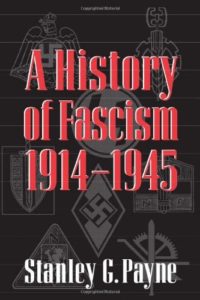 In fact, this robustness even characterized the political systems of belligerent north-western countries during World War I. As Stanley Payne (left, 1996: 73–5) points out, the democracies of France and the United Kingdom (and of course the US) were so stable that they could deal with the massive strain of the war—that is, with the mobilization of the economy and the population for four years of protracted warfare—within the political regime, for example, via the creation of ‘national unity governments’. This stands in stark contrast to the situation in the authoritarian regimes in central, southern, and eastern Europe, where the strain of warfare either produced outright regime collapse (Russia) or some kind of de facto military dictatorship (Germany and Austria-Hungary). In a sense, the very same pattern was reproduced during the interwar period, where the old democracies with robust associational landscapes could channel the frustration created by social, economic, and political crises, whereas the new democracies with weak associational landscapes could not. Indeed, the case study of France showed that even where democracy was effectively paralyzed by the Great Depression, probably due to a lack of extensive linkages between political parties and civil society, it would survive if all actors had long since become habituated to it.
In fact, this robustness even characterized the political systems of belligerent north-western countries during World War I. As Stanley Payne (left, 1996: 73–5) points out, the democracies of France and the United Kingdom (and of course the US) were so stable that they could deal with the massive strain of the war—that is, with the mobilization of the economy and the population for four years of protracted warfare—within the political regime, for example, via the creation of ‘national unity governments’. This stands in stark contrast to the situation in the authoritarian regimes in central, southern, and eastern Europe, where the strain of warfare either produced outright regime collapse (Russia) or some kind of de facto military dictatorship (Germany and Austria-Hungary). In a sense, the very same pattern was reproduced during the interwar period, where the old democracies with robust associational landscapes could channel the frustration created by social, economic, and political crises, whereas the new democracies with weak associational landscapes could not. Indeed, the case study of France showed that even where democracy was effectively paralyzed by the Great Depression, probably due to a lack of extensive linkages between political parties and civil society, it would survive if all actors had long since become habituated to it.
The historical baseline was thus imprinted into the pre-war democratic legacies and the interwar vibrancy of associational landscapes. These factors again channelled a series of deeper historical factors, most importantly socio-economic modernization (affluent versus poor countries). Our findings therefore corroborate the notion that the north-western countries and, to a lesser extent, the Southern Cone countries in Latin America, were simply in a different category at the beginning of the interwar period. This was reflected in manifest differences in
associational landscapes that, in turn, correlate with deeper historical factors. The distinction between north-western Europe and the former British settler colonies, and the other country clusters is also reflected in prior attempts to measure interwar democratic spells. If universal adult suffrage is disregarded, there is hardly any disagreement that the north-western countries were democratic throughout the interwar period. This is a very stark contrast with the rest of Europe and Latin America, where prior datasets have come to strikingly different
conclusions about the existence of democratic spells, if any.
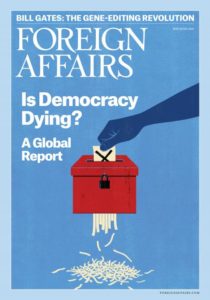 These findings underline the importance of integrating what we have termed structuralist and associationalist theories, respectively. A set of structural conditions, brought about by deeper processes of state formation and economic and socio-cultural developments, created different baseline risks of breakdown at the beginning of the interwar period, which in the 1920s and 1930s translated into breakdown or survival via the collective actors in civil society and the parties. The evidence that deeper structural factors created two different kinds of interwar democracies meanwhile raises serious doubts about the explanatory purchase of voluntaristic elite theories, at least if the aim is to explain general patterns of interwar regime change. These patterns seem to have been heavily structured from the beginning, leaving little independent explanatory leverage for actors’ contingent choices.
These findings underline the importance of integrating what we have termed structuralist and associationalist theories, respectively. A set of structural conditions, brought about by deeper processes of state formation and economic and socio-cultural developments, created different baseline risks of breakdown at the beginning of the interwar period, which in the 1920s and 1930s translated into breakdown or survival via the collective actors in civil society and the parties. The evidence that deeper structural factors created two different kinds of interwar democracies meanwhile raises serious doubts about the explanatory purchase of voluntaristic elite theories, at least if the aim is to explain general patterns of interwar regime change. These patterns seem to have been heavily structured from the beginning, leaving little independent explanatory leverage for actors’ contingent choices.
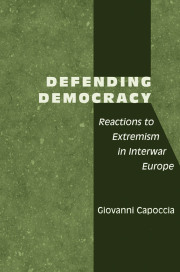 Likewise, performance theories, at most, seem to have a place within our theoretical framework, rather than as an independent theoretical perspective. That is, democratic legacies and vibrant associational landscapes allowed democratic systems to respond more effectively to the crises of the day, and this is in turn reinforced democracy. Only in the small group of moderately well-established democracies does the focus on performance have direct explanatory purchase, and this is exactly because these countries did not have as well-functioning associational landscapes couched in pre-war democratic legacies. Likewise, the focus on actors’ choices seems most relevant in the few ‘near misses’, where there might
Likewise, performance theories, at most, seem to have a place within our theoretical framework, rather than as an independent theoretical perspective. That is, democratic legacies and vibrant associational landscapes allowed democratic systems to respond more effectively to the crises of the day, and this is in turn reinforced democracy. Only in the small group of moderately well-established democracies does the focus on performance have direct explanatory purchase, and this is exactly because these countries did not have as well-functioning associational landscapes couched in pre-war democratic legacies. Likewise, the focus on actors’ choices seems most relevant in the few ‘near misses’, where there might
have been structural reasons for more contingency in outcomes (Capoccia 2005). Nonetheless, when push came to shove none of the ‘old’ European democracies broke down, indicating that even here actors’ choices might not have independent explanatory power. More particularly, our case study of France questions the notion that democracy came close to breaking down during the 1930s, and hence the idea that interwar France can be construed as a ‘near miss’.
The Real Lessons of the Interwar Period
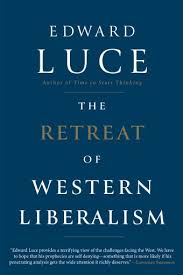 The story about democratic breakdown and survival in the interwar period is fascinating in its own right. It covers a period of genuine political conflict over democracy, both within countries and in international relations. The outcome of these conflicts was to shape the period that followed. Only by understanding the interwar period can we understand the Cold War contest between liberal democracies and communist one-party regimes as well as the democratization processes that have characterized the period after 1989. However, the interwar period is not only relevant for understanding the period that followed World War II. It also affects how we attempt to come to terms with political developments in our own time. The best example of this is the recurrent tendency to warn that interwar developments are about to repeat. Indeed, it is
The story about democratic breakdown and survival in the interwar period is fascinating in its own right. It covers a period of genuine political conflict over democracy, both within countries and in international relations. The outcome of these conflicts was to shape the period that followed. Only by understanding the interwar period can we understand the Cold War contest between liberal democracies and communist one-party regimes as well as the democratization processes that have characterized the period after 1989. However, the interwar period is not only relevant for understanding the period that followed World War II. It also affects how we attempt to come to terms with political developments in our own time. The best example of this is the recurrent tendency to warn that interwar developments are about to repeat. Indeed, it is
hardly an exaggeration to say that whenever the possibility of democratic backsliding
is mentioned, at least in Europe, the ghost of the interwar period is invoked.
On the basis of the evidence adduced in this book, we argue that the real lesson of the interwar period is that crisis—even as devastating as the Great Depression and the political success of totalitarian movements—had little bite in established, affluent democracies. Only in new democracies without strong associational landscapes did the economic, political, and social dislocations of the 1920s and 1930s tear apart the democratic fabric. Accordingly, what we termed the interwar analogy—the notion that crisis led to democratic breakdown in the 1920s and 1930s and is therefore likely to do so again today, even in well-established, affluent democracies—is based on a superficial reading of interwar political developments. It might well be that the rich democracies of Western Europe and North America are presently facing a perilous situation, but the political developments of the interwar period do not support the notion that even old and affluent democracies are inherently fragile; au contraire.
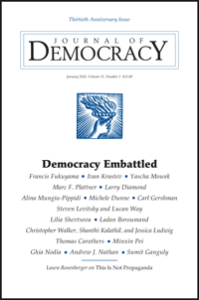 Based on what we know about the causes of democratic stability, the many democratic breakdowns in the interwar period are really rather unsurprising. What is genuinely spectacular is the democratic stability of the countries in the northwestern Europe and the former British settler colonies. This was a period where democracy was on the defensive, in hearts and minds and on the inter national scene. It was a period of mass unemployment, with millions of unemployed, battle-hardened veterans, where democracies faced a cascade of anti-democratic demonstration effects from undemocratic dictatorships of leftist and rightist hues. It was a period where the market economy seemed unable to match the performance of planned economies and where the might of the strong seemed destined to prevail over the right of the weak in the international system. Nonetheless, in most of the old democracies in the north-west, we find little in the way of political radicalization or political paralysis, and we actually find indications that democratic quality increased even in the crisis-prone 1930s.
Based on what we know about the causes of democratic stability, the many democratic breakdowns in the interwar period are really rather unsurprising. What is genuinely spectacular is the democratic stability of the countries in the northwestern Europe and the former British settler colonies. This was a period where democracy was on the defensive, in hearts and minds and on the inter national scene. It was a period of mass unemployment, with millions of unemployed, battle-hardened veterans, where democracies faced a cascade of anti-democratic demonstration effects from undemocratic dictatorships of leftist and rightist hues. It was a period where the market economy seemed unable to match the performance of planned economies and where the might of the strong seemed destined to prevail over the right of the weak in the international system. Nonetheless, in most of the old democracies in the north-west, we find little in the way of political radicalization or political paralysis, and we actually find indications that democratic quality increased even in the crisis-prone 1930s.
The lesson we draw is that interwar patterns of regime change have been interpreted in an overly pessimistic way. There is room for a more optimistic interpretation that emphasizes the democratic stability of the established democracies in the face of the multiple crisis episodes of the interwar period. A systematic analysis of patterns of interwar regime change reveals that once democracy has taken root, it tends to be remarkably stable, even under very adverse circumstances.
Present-day Implications
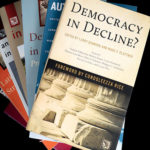 Here, we can return to the big bogeyman of the interwar period: economic crisis. There is a common consensus among scholars, pundits, and laymen that the Great Depression of 1929–33 triggered numerous breakdowns as elites and masses lost confidence in the ability of the democratic political systems to provide a remedy. As mentioned above, this issue has recently become particularly pertinent due to the focus on the potentially delegitimizing consequences of the Great Recession that began in 2008. Many observers have enlisted interwar developments to make the case for economic crisis presenting a similar threat to democratic stability today.
Here, we can return to the big bogeyman of the interwar period: economic crisis. There is a common consensus among scholars, pundits, and laymen that the Great Depression of 1929–33 triggered numerous breakdowns as elites and masses lost confidence in the ability of the democratic political systems to provide a remedy. As mentioned above, this issue has recently become particularly pertinent due to the focus on the potentially delegitimizing consequences of the Great Recession that began in 2008. Many observers have enlisted interwar developments to make the case for economic crisis presenting a similar threat to democratic stability today.
The fact that we find so little general evidence of negative effects of economic crisis on outright democratic breakdown in the interwar period accordingly has some important implications. If the economic crisis of the interwar period—the deepest crisis of modern times, in a period where democracy was challenged in a more general sense—mainly contributed to democratic breakdown in a handful of moderately well-established democracies, one must be sceptical about the ability of economic crisis to do so in other periods, with less deep economic crisis
and fewer challenges to democracy as a regime form.
Furthermore, our findings show that democratic legacies and vibrant associational landscapes mitigate the risk of democratic breakdown, even in the face of crisis. Thus, we would—pace some recent warnings (see, e.g., Krugman 2011; Schmitter 2012)—not expect economic crisis to be capable of triggering breakdown in affluent countries with a long legacy of democracy today. Of course, economic crisis could still cause decreases in democratic quality or even an increase in political radicalization, possibly met by some increase in political repression. But these would be political crises within the context of democratic survival; not crises that involve democratic breakdown.
Similarly, even if the Western liberal hegemony in international affairs, which has held sway since 1989 (Levitsky & Way, above, 2010), is in the process of being replaced by an international order that is less conducive to democracy due to the rise of autocratic great powers such as China, this is unlikely to imperil today’s equivalent of the old north-western democracies, a category that is probably much larger than it was in the interwar period. On the basis of our analysis, only new, poor and—hence—fragile democracies would be negatively affected by anti-democratic demonstration effects from undemocratic great powers.
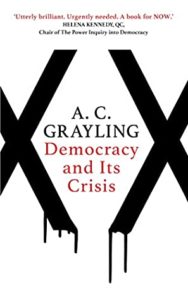 This does not necessarily mean that today’s Western democracies are safe or that we should be complacent about current challenges to democracy. History does not repeat itself in simple ways, and new threats might well render affluent, established democracies more fragile than was the case in the 1920s and 1930s. Many commentators today seem to argue that what we are seeing at present is a deep legitimacy crisis for democracy, which is in many ways internal to political systems such as the American, the Italian, and possibly even the British. More particularly, in recent years, scholars and pundits have adduced a number of examples to the effect that a genuine democratic crisis is threatening (e.g., Grayling, left, 2018; Klaas 2016; Luce, above, 2017; Puddington & Roylande 2017; Rich, above, 2017).
This does not necessarily mean that today’s Western democracies are safe or that we should be complacent about current challenges to democracy. History does not repeat itself in simple ways, and new threats might well render affluent, established democracies more fragile than was the case in the 1920s and 1930s. Many commentators today seem to argue that what we are seeing at present is a deep legitimacy crisis for democracy, which is in many ways internal to political systems such as the American, the Italian, and possibly even the British. More particularly, in recent years, scholars and pundits have adduced a number of examples to the effect that a genuine democratic crisis is threatening (e.g., Grayling, left, 2018; Klaas 2016; Luce, above, 2017; Puddington & Roylande 2017; Rich, above, 2017).
Much attention has been lavished on the political developments in countries such as Hungary, Poland, Turkey and Venezuela, where populists have won landslide victories and attempted to concentrate power in the executive and curtail the independence of the courts and media. Moreover, the pessimism has been fed by the strong showing of populist parties and candidates in much of Western Europe and in the US. In the summer of 2016, Brexit was taken as evidence that even in a stable democracy like the United Kingdom, there is a seething opposition against what is seen as self-serving political and economic elites. Finally, Donald Trump’s victory in the US presidential election on 8 November 2016 opened a floodgate of
dire warnings.
 It remains to be seen whether these developments are mere political ripples on the surface, whether they are early signs of a reverse wave of democracy, or of a milder but still troubling decline in democratic quality in Western democracies. Nonetheless, we are adamant that the interwar experience cannot be used to support the latter, gloomy predictions. If anything, it does the opposite as it reminds us of the remarkable vigour of affuent, established democracies in the face of crisis. This might be the most important lesson about democratic stability that can be inferred from the interwar period.
It remains to be seen whether these developments are mere political ripples on the surface, whether they are early signs of a reverse wave of democracy, or of a milder but still troubling decline in democratic quality in Western democracies. Nonetheless, we are adamant that the interwar experience cannot be used to support the latter, gloomy predictions. If anything, it does the opposite as it reminds us of the remarkable vigour of affuent, established democracies in the face of crisis. This might be the most important lesson about democratic stability that can be inferred from the interwar period.
The above extract is from the concluding chapter of Democratic Stability in an Age of Crisis: Reassessing the Interwar Period. Agnes Cornell, Jørgen Møller, and Svend-Erik Skaaning, Oxford University Press (2020).







